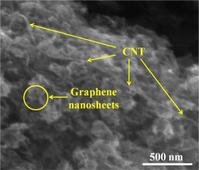Thermal and electrical properties of graphene/carbon nanotube aerogels
Thermal and electrical properties of graphene/carbon nanotube aerogels
| Event Date: | March 20, 2014 |
|---|---|
| Authors: | Z. Fan, D.Z.Y.Tng, C.X.T. Lim, P. Liu, S.T. Nguyen, P. Xiao, A. Marconnet, C.Y.H. Lim, H.M. Duong |
| Journal: | Colloids and Surfaces A |
| Paper URL: | Link to Full Text |
Highlights
• Effects of reducing agents and CNTs on morphologies and properties of GAs
• Annealing and addition of CNTs enhances electrical conductivities of the GAs up to 5 times
• The thermal conductivity of the GAs is measured to be ∼0.10 W/(m K)
• Thermal stability of annealed GAs are higher than those of non-annealed GAs
Abstract
Graphene and carbon nanotube (CNT) aerogels provide combinations of mechanical, thermal, and electrical properties that are interesting for a variety of applications. In this work, the impact of three different reducing agents (L-ascorbic acid (LAA), HI and NaHSO3) and carbon nanotubes on the morphologies and properties of the graphene aerogels (GAs) are studied systematically. Additional, thermal annealing at 450°C for 5 h under Ar environment is also investigated. Annealing treatment and the addition CNTs enhance the electrical conductivities of the GAs up to a factor of 5. Thermal annealing impacts the surface area of the GAs. Specifically, the surface areas of those reduced by HI and NaHSO3 decreased by 30%, while those reduced by LAA or dispersed with CNTs increased by 15%. The thermal conductivity of the highly porous GAs is measured using an improved infrared microscopy technique to be ∼0.10 W/(m K).

